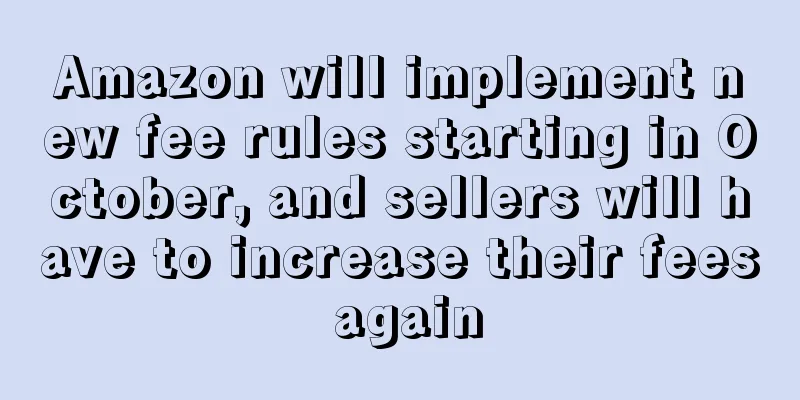Amazon will implement new fee rules starting in October, and sellers will have to increase their fees again

|
Amazon will implement new charging regulations. Starting from October, some sellers will face rising costs. Some sellers estimate that annual losses may reach US$100, while others say that profits will be directly reduced by one-third.
As Amazon's operating costs have continued to rise in recent years and competition among sellers has intensified, it has become more difficult to make a profit.
Amazon to impose new fees on third-party sellers
According to a notice issued by Amazon, starting from October 1, third-party sellers on Amazon who ship their own products will need to pay an additional fee for each product sold, and many sellers believe that this charge is mandatory.
Previously, sellers did not need to pay this fee to Amazon, but Amazon's new fee rules mean that sellers using the Seller fulfillment Prime Program will need to pay a 2% fee for each product sold, or at least $0.25 per product. In other words, sellers have two options: either pay 2% or pay $0.25, depending on the product's selling price.
The new fee is in addition to Amazon's commission on products sold , which ranges from 8% to 15% depending on the product category.
It is worth noting that this fee is not included in the cost of self-fulfillment Prime. If sellers want to join the self-fulfillment Prime program, they need to pay $0.99 for each product sold , or choose to pay $39.99 per month, regardless of the sales quantity.
The Seller Fulfillment Prime Program was launched in 2015. Sellers can ship independently without paying Amazon, and use the program to get the Amazon Prime member badge, letting buyers know that the products they purchase can be delivered quickly. However, a few years later, Amazon closed the registration for the program because the platform believed that it was difficult for sellers to meet the relevant delivery standards.
In June this year , Amazon announced that it would reopen registration for Seller fulfillment Prime membership. The company did this in response to antitrust allegations made by regulators.
The Federal Trade Commission is reportedly planning to file an antitrust lawsuit against Amazon, accusing the company of rewarding third-party sellers who use its logistics services while penalizing those who deliver their own goods. The latest lawsuit against the giant comes months after FTC Chairwoman Lina Khan announced plans to do so .
As things stand, sellers are already burdened with costs including inventory fees, book rental services, bulk listing fees, and refund management fees, and the addition of another charge has caught many sellers off guard.
Lowering profits, some sellers will lose up to $100 a year
One seller said he received a notice of a 2% fee increase, and that such a sudden adjustment was difficult to adapt to because many sellers had already prepared sufficient inventory for the upcoming holiday season .
It is understood that sellers who use self-delivery usually sell larger goods, such as furniture, which are not well matched with Amazon's highly automated warehouses. Amazon's warehouses are mainly used to handle smaller products , and large products will be charged higher storage fees.
After receiving the new fee adjustment notice, some sellers said they would face significant losses.
An office furniture seller who signed up for Seller Fulfillment Prime said the new fee would cost his company about $1 million a year, forcing it to raise prices. However, he may choose to continue using the service because Amazon has a large customer base and the new fee may not be profitable .
Another seller also said that they would raise prices to cope with the new fees , and said that for many sellers using this service , the 2% fee would reduce already thin profits by another third , and Amazon only gave sellers a few weeks.
Since the beginning of this year, whether it is self-shipping sellers or FBA sellers, everyone feels that their profits are constantly being reduced. Competition among sellers in multiple categories is fierce, and price wars continue.
A seller launched a new product in April, with a profit of 30% and 7-10 orders a day. When competitors appeared, the price kept dropping, and the profit dropped from 30% to 0 in just 2 months. There were also competitors who encountered crazy price cuts, discounts, and various discounts after launching their products, and finally had to sell out their inventory at a loss.
The current situation of declining profits has occurred in many categories. Some sellers have compared their profits this year with those of the same period last year, and some have dropped by more than 50%. Under such circumstances, Amazon's increase in fees is undoubtedly a fatal blow to some sellers!
Sellers’ operating costs continue to increase
In recent years, Amazon has been raising fees on sellers, and sellers on its platform typically need to pay commissions, advertising fees, logistics fees, etc. to maximize sales.
According to foreign media, in terms of profitability, as some of Amazon's core online operations slow down, it needs to charge sellers more service fees to balance it, so charging sellers is becoming increasingly important.
It is understood that more than 60% of sales on the Amazon platform come from third-party sellers. In the second quarter of this year, seller services generated $32.3 billion in revenue, an increase of 18% year-on-year, exceeding the lucrative cloud service business.
According to data released by the statistics agency Marketplace Pulse, the proportion of fees charged by Amazon to sellers' sales has increased year by year, and in 2022 it broke the 50% mark for the first time.
As costs continue to rise, many sellers find that a lot of their profits are eaten up by Amazon when they calculate their profits . In addition, sellers also need to pay for inventory, shipping, employee wages and various other expenses . This makes it difficult for sellers to make a profit.
Amazon's FBA fees have also been rising steadily over the years. Amazon raises delivery fees and storage fees every year. This year, Amazon has officially announced that it will increase FBA shipping fees during the holiday shopping peak, effective from October 15, 2023 to January 14, 2024.
This year’s holiday peak delivery fees apply to US FBA, Canada FBA, Amazon Remote Fulfillment Program, and Multi-Channel Fulfillment (MCF), except for US FBA with list price less than $10.
Some sellers expressed dissatisfaction with Amazon's increase in holiday delivery fees: "I can't believe they dared to increase delivery fees during the peak shopping period this year. Now our sales have dropped significantly. Amazon has not taken any action except charging sellers more fees."
Many sellers believe that Amazon charges a 2% fee to self- shipping sellers in order to force them to use FBA, but Amazon has not explained this. Bloomberg asked Amazon about this issue and the response was that this would help cover the cost of running a separate infrastructure and measuring its effectiveness.
An Amazon spokesperson said : “We’re excited to offer sellers Fulfilled by Prime membership, a way for sellers to independently handle product fulfillment while still providing Prime customers with the fast, free shipping, great customer service and free returns they enjoy.” Amazon New regulations Seller cost |
<<: After working alone for three months, Amazon operations became a worker again
Recommend
What is brilliantapp? brilliantapp Review, Features
Brilliantapp is used to connect Amazon product inf...
520,000 new sellers enter Amazon, and 1/3 of cross-border sellers have negative annual sales growth
According to a survey of 300 sellers by an indust...
220 time-honored brands doubled their sales during Tmall Double 11; time-honored brands are the most successful new brands
Tradition has transformed into fashion and trends...
Online sales continue to grow, and the latest toy trends for 2021 are released
Since the start of the COVID-19 pandemic, the toy...
Halloween goes online! Online sales will reach $3 billion in 2021!
Like other economic industries , the main battlef...
US e-commerce startup Shipium raises $130 million
U.S. e-commerce startup Stackline has received $1...
What is Amazon Advertising? Amazon Advertising Review, Features
Amazon advertising, also known as "keyword a...
DHL releases preliminary third quarter financial report, with profits up 28%!
In the third quarter of 2021, DHL Group's ear...
Japan's personal cash holdings exceeded 100 trillion yen for the first time!
According to the statistics on fund circulation f...
Products are popular on TikTok, and Guangzhou sellers have entered the top five of Amazon's best-selling list
Entering the top five of the best-selling list, G...
Oxygen concentrator exports are booming, and some companies have suspended accepting orders
In recent times, the topic that often dominates h...
What is AmzChart? AmzChart Review, Features
AmzChart is a free Amazon product selection tool ...
Shenzhen Dama became the defendant after losing the bet and had to pay 70 million yuan in compensation
There are very few successful bets in the cross-b...
Daily sales of more than 8,000 orders! A "dark horse" emerges in the red ocean category
In recent days, sellers have been complaining abo...
A large number of Amazon sellers have seen a sharp drop in inventory capacity, with some sellers exceeding 20,000...
There have been many major events in the cross-bo...









